Written by: David, Deep Tide TechFlow
The crypto market has its own 'boy who cried wolf' story.
On August 3, a well-known foreign financial news platform First Squawk posted on social media: 'China has officially banned cryptocurrency trading, mining, and related services, citing financial risks, capital outflow issues, and environmental impacts.'

Meanwhile, overseas financial giants like Investing.com and Rawsalerts, which have millions of followers, successively retweeted this unverified 'breaking news.' Clearly, using China's ban on cryptocurrencies as a talking point has become a 'traditional skill' of fake news in the crypto market.
In the comments section of this news, there was a humorous comment—Grok, asking me, how many times has China banned cryptocurrency?
Veteran investors have long been aesthetically fatigued by such fake news, and the price of Bitcoin has long been immune to this kind of fake news.
However, the crypto market indeed has an absurd cycle—every so often, a highly influential piece of fake news will emerge.
You may be immune to the cycle of the Chinese ban, but you may not be immune to the emergence of all fake news. When enough people believe a piece of fake news will affect the price, it really will affect the price.
China's 'ban' is just the tip of the iceberg of the entire crypto market's susceptibility to fake news. Reviewing the entire history of the crypto market, those heavyweight fake news pieces have genuinely impacted the trajectories of crypto assets;
Behind a piece of fake news, you can even see a hidden information dissemination chain.
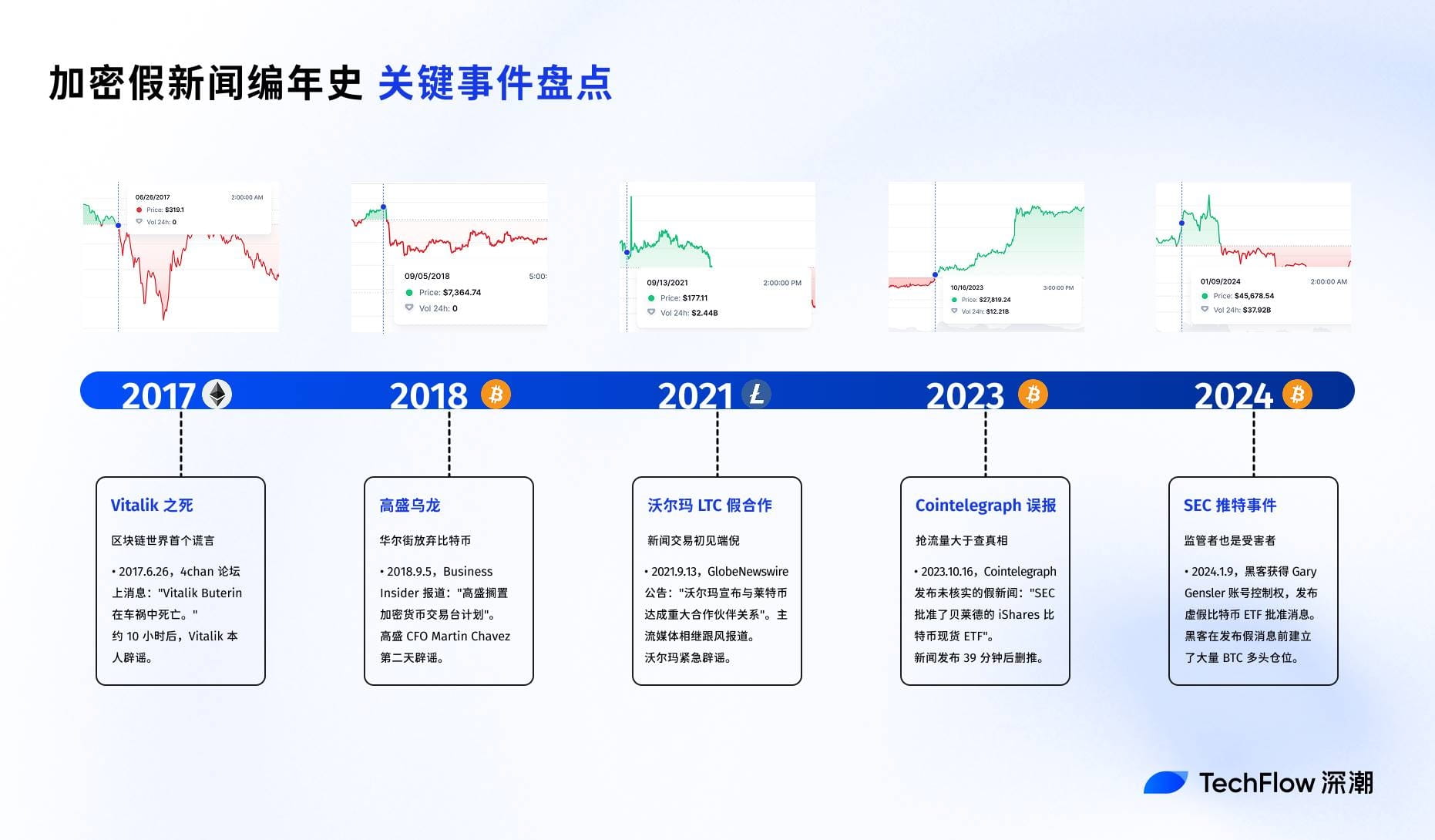
Chronology of Crypto Fake News: From Amateur to Professional, Key Events Overview.
2017: The death of Vitalik, the first lie in the blockchain world.
If one were to write an evolutionary history of cryptocurrency fake news, June 26, 2017, would undoubtedly be a milestone.
That afternoon, a message appeared on the well-known foreign forum 4chan: 'Vitalik Buterin died in a car accident.' No source, no evidence, not even any decent details.
Yet this rough rumor triggered the first market crash in cryptocurrency history caused by fake news within the next few hours. At that time, ETH dropped from $317 to $216 in just six hours, a decline of nearly 32%.
Reddit's r/ethtrader section was filled with posts asking 'Is this true?' 'Can anyone confirm?' In Telegram groups, holders debated whether they should sell immediately.
About 10 hours after the rumor spread, Vitalik himself posted a photo on Twitter holding the Ethereum block number and hash value from that day to debunk it, proving he was still alive through the blockchain itself.

Vitalik is still here, but your position may be gone.
The market's reaction at the time revealed a cruel truth: in the early wild west of the crypto world, the destructive power of an anonymous post could be comparable to that of an official announcement.
Early fake news creators were mostly amateur players. They either established so-called insider groups on Telegram or posted on forums like 4chan. This is a market with extreme information asymmetry, where retail investors are groping in the dark, and any slight movement can trigger a stampede.
Fake news during this period was more like a prank by a few individuals, tied to the founders of the projects; the market directly linked the personal safety of the founders with the survival of the projects.
2018: Goldman Sachs blunder, Wall Street abandons Bitcoin.
And when fake news dresses in a suit, the destructive power of professional 'exclusive news' is even greater.
On September 5, 2018, the cryptocurrency market was shrouded in the gloom of a bear market. At this sensitive moment, the well-known American business site Business Insider published a report with a title that hit the nail on the head: 'Goldman Sachs Suspends Cryptocurrency Trading Desk Plan.'
The so-called 'Trading Desk' is a department in investment banks that buys and sells specific financial products for clients. If Goldman Sachs really establishes a cryptocurrency trading desk, it means its institutional clients can buy and sell Bitcoin through Goldman Sachs, which was seen at the time as an important milestone for cryptocurrency gaining mainstream recognition; while 'suspended' hints at the abandonment of cryptocurrencies.
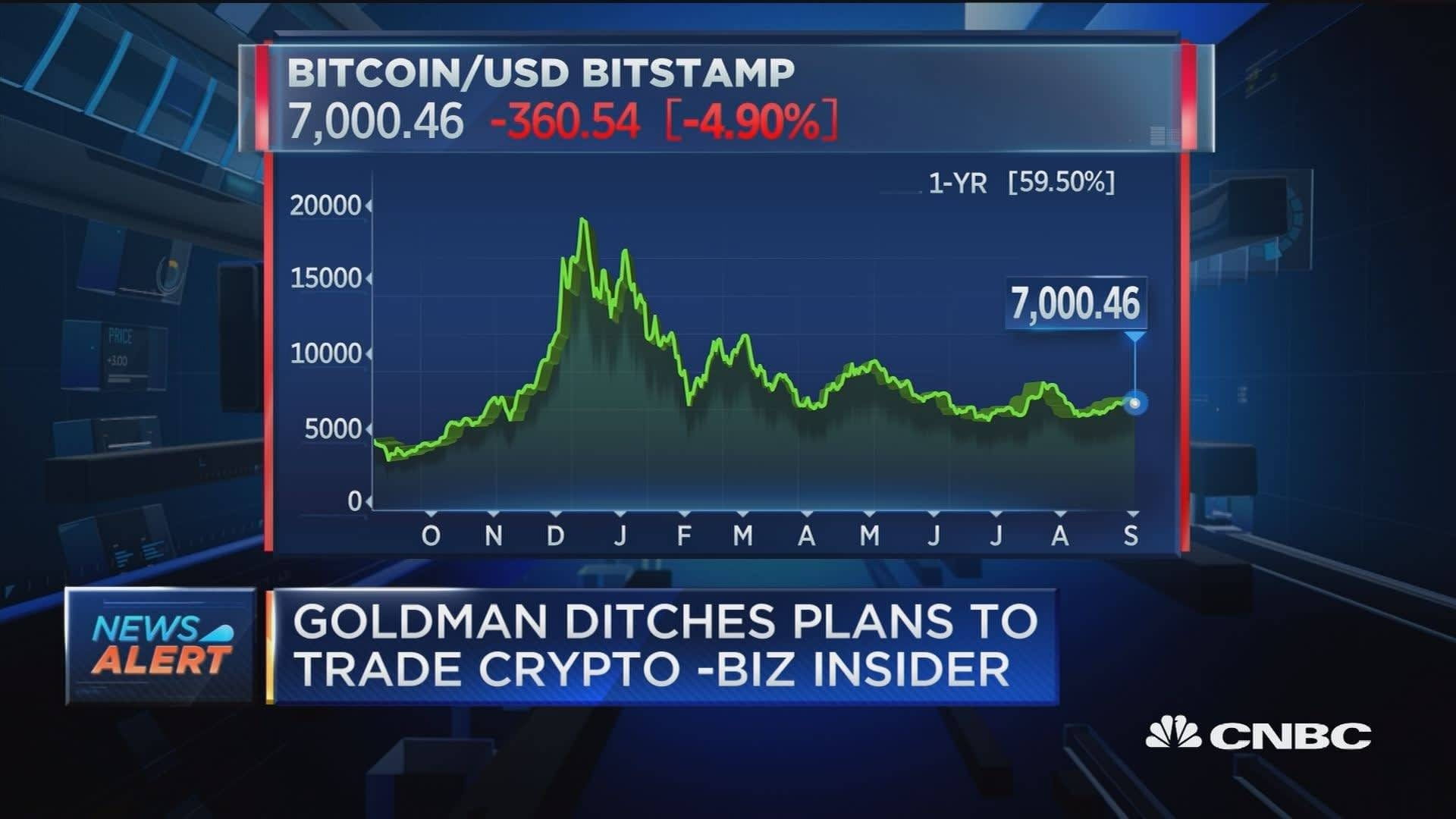
The next day, the plot took a turn. When Goldman Sachs CFO Martin Chavez was asked about this matter at the TechCrunch conference, his response left everyone speechless: 'I was still wondering yesterday, when did I make this decision? This is fake news.'
But the clarification comes too late. During that panic-stricken 24 hours, a large number of investors had already cut their positions and left the market.
According to Cointelegraph's report at the time, the prices of Bitcoin and other digital currencies plummeted following the so-called news from 'insider sources,' with a total market value dropping by $12 billion within an hour, of which Bitcoin fell over 6% that day.
2021: Walmart and Litecoin's fake collaboration, signs of news trading emerge.
If the previous fake news might still be a misunderstanding or oversight, then the fake news about Walmart's collaboration with Litecoin on September 13, 2021, was a premeditated crime.
At 9:30 that morning, an announcement appeared on GlobeNewswire, one of the world's largest press release distribution services.
The headline is striking: 'Walmart Announces Major Partnership with Litecoin.' The press release is well-made, containing all the elements of a professional press release: Walmart's official logo, detailed cooperation plans, quotes from executives, and even contact information for the investor relations department.

The press release claimed that starting October 1, all Walmart e-commerce sites would provide the option to 'pay with Litecoin.' It also quoted Walmart CEO Doug McMillon as saying, 'Cryptocurrency will play an important role in our digital strategy.'
Subsequently, some crypto media began to rush to report this information, and most critically, the official Twitter account of the Litecoin Foundation retweeted the news.
In that time before the 'coin-stock linkage' play, when crypto was less mainstream, the market's reaction was explosive.
The price of Litecoin began to rise vertically, and trading volume surged. Mainstream media also joined the dissemination chain—CNBC and Reuters reported successively; by 10:30 that day, the price of Litecoin reached its peak, rising over 30%.
However, just as the market fell into a frenzy, Walmart's PR team noticed something unusual. After urgent verification, they issued a statement: This is false news; Walmart has no partnership with Litecoin.
After the news turned around, the price of Litecoin dropped like a free fall. But for the manipulators behind the scenes, the game was already over.
Subsequent investigations revealed that there had been unusual Litecoin bullish options trading in the market 48 hours before the fake news was released. The manipulators profited millions of dollars from this scheme through careful planning.
The terrifying aspect of this event lies in its professionalism.
From registering similar domain names, creating fake press releases, to choosing the timing of publication and using official accounts for endorsement, every step was carefully calculated. This was not just a prank about Vitalik's death; it was a more premeditated and organized crime, attempting to profit through news trading.
2023: Cointelegraph's false report, prioritizing traffic over verifying the truth.
October 16, 2023, is a day worthy of reflection for the cryptocurrency media industry.
At 1:17 PM, a screenshot from a Telegram group began to circulate in the crypto community. The screenshot showed a message allegedly from the Bloomberg terminal interface: the SEC had approved BlackRock's iShares Bitcoin spot ETF.
For cryptocurrency investors who have waited for years, this is undoubtedly a historic moment.
Cointelegraph's social media team saw this news. As one of the largest cryptocurrency media outlets globally, they certainly understood the significance of this news.
But before publishing, they faced a dilemma: should they spend time fully verifying the information, risking being scooped by other media? Or should they publish immediately and seize the traffic?
At 1:24, just 7 minutes later, Cointelegraph posted this 'breaking news' on its official X account. The tweet was very eye-catching: 'Breaking: SEC Approves BlackRock Spot Bitcoin ETF.'
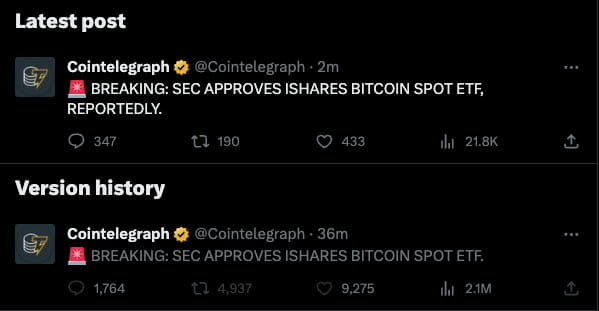
The market's reaction was immediate and severe, with the price of Bitcoin soaring from $27,900 to $30,000 within the next 30 minutes, an increase of over 7%; trading volume surged, and the servers of major exchanges felt the pressure. The derivatives market was even crazier, with $81 million in short positions forcibly liquidated in this sudden spike.
However, excitement soon turned into confusion. Observant individuals began to raise questions:
Why is only Cointelegraph reporting? Why is there no announcement on the SEC's official website, and why is BlackRock silent?
At 2:03 PM, 39 minutes after posting the tweet, Cointelegraph deleted the original tweet. But the damage had already been done. In less than an hour, the market experienced a complete cycle of rise and fall.
According to a subsequent investigative report published by the media, the error originated from a loss of internal process control—social media editors violated the regulations requiring editorial confirmation before publication.
This incident sparked intense discussion within the industry. A sharp viewpoint argues that when media prioritizes speed over accuracy, they cease to be media and become tools for market manipulation.
Crypto media face immense pressure. This is a 24/7 market, and news can break at any time. If you are 5 minutes late, the traffic will be snatched away by others. In this environment, publishing first and verifying later is a risky but highly rewarding choice, but it may also cost you credibility.
In traditional financial markets, major news is usually released uniformly through official channels, with strict information disclosure rules. But in the crypto market, information channels are decentralized and hard to distinguish between true and false. A screenshot or a tweet can trigger the movement of billions of dollars.
Ironically, when the SEC truly approved the Bitcoin ETF in January 2024, the market's first reaction was not cheers but skepticism.
2024: SEC Twitter incident, regulators are also victims.
In January 2024, the SEC's official X account released false news about the approval of a Bitcoin ETF. According to subsequent investigations by the FBI, the attackers gained control of the account through a SIM swap attack. The price of Bitcoin rose from $46,600 to $47,680 after the fake news was released, and fell to $45,627 after the debunking.
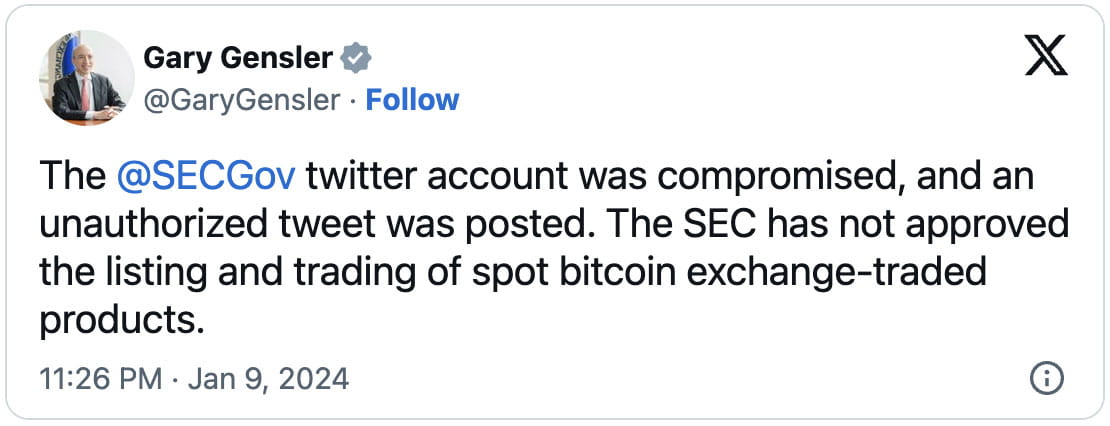
In October 2024, the FBI arrested suspect Eric Council Jr. Court documents revealed this was a premeditated financial crime, with the attackers establishing a large number of long positions in Bitcoin before releasing the fake news.
Over the past decade, cryptocurrency fake news has transformed from 'innocent mistakes' to 'premeditated crimes.' The technical thresholds, funding scales, and organizational levels are all upgrading; you might have dodged one piece of fake news, but you can't guarantee you won't get hit by the next one.
Three people make a tiger; when the truth is diluted.
In the crypto market, tracking the source of a piece of fake news is often futile.
When news like 'China has banned cryptocurrency again' stirs the market, the large number of retweets, algorithm recommendations, and the increased discourse power of self-media make it impossible for anyone to clarify where the information originally came from.
A typical path of spreading crypto fake news can look like this:
The first layer of sources is usually small Telegram channels or Discord groups, and tracking the source is almost impossible. The publishers often use anonymous accounts, and even if exposed, they suffer no loss.
The second-tier small circles fermented the information among several related groups, beginning to add 'evidence'—PS images, fabricated details, seemingly logical reasoning, etc.;
Third-tier crypto media platforms give news a 'quasi-official' color. Even when using disclaimers like 'according to informed sources,' readers often choose to selectively ignore.
The fourth tier of KOL involvement: when the news spreads to a certain extent, KOLs face the choice of whether to publish or not—most choose a strategy of 'retweeting but not endorsing'—using phrases like 'it is said that' or 'there are reports that.'
The fifth layer of market reaction: once prices start to fluctuate, fake news gains 'market validation.' The decline itself becomes 'evidence' of the news's authenticity.
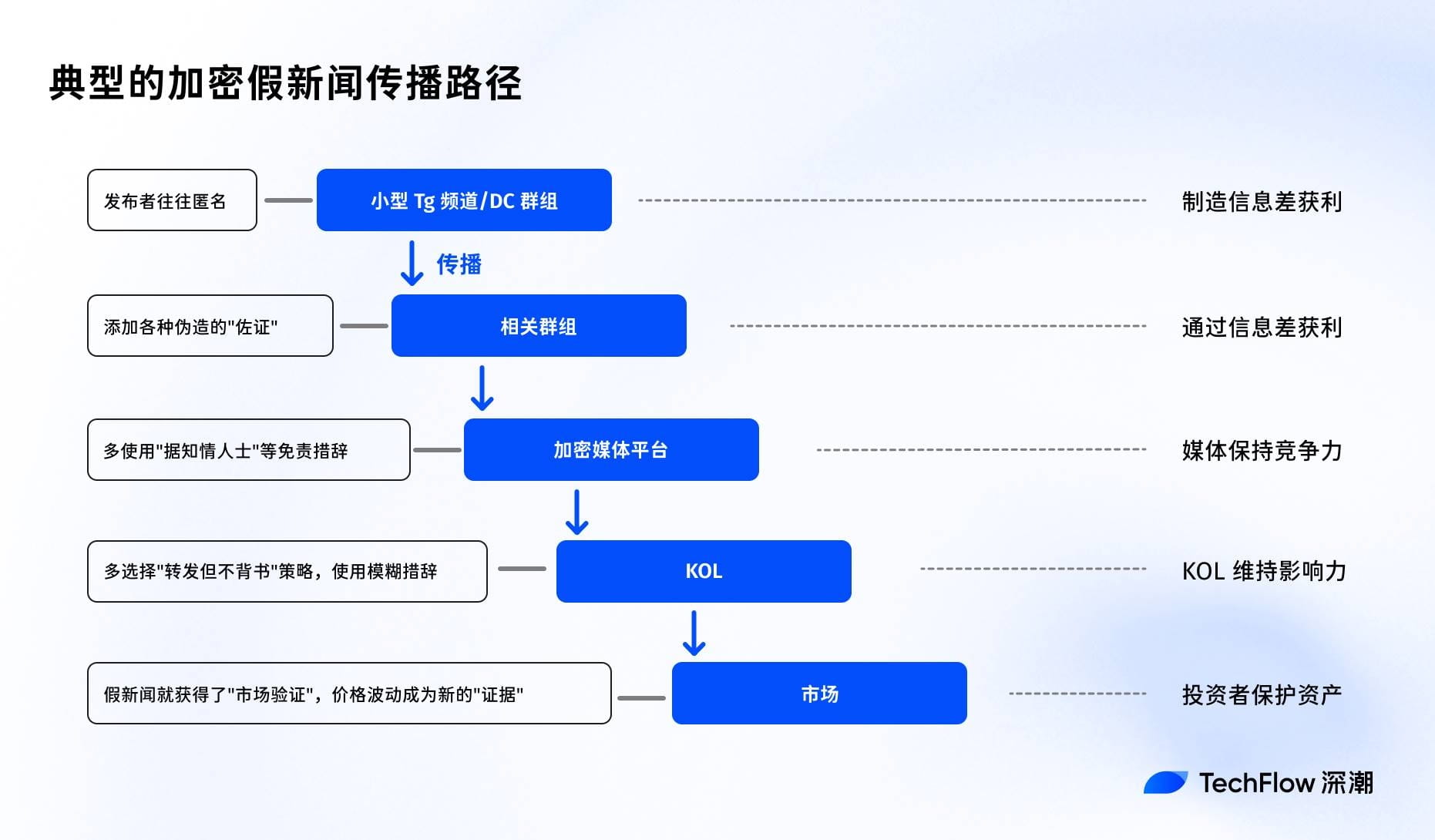
When a piece of news is disseminated through multiple layers, tracing the source becomes nearly impossible. Each layer of dissemination adds new 'details' and introduces new explanations until the original information is completely diluted.
In the crypto market, rumors can spread irresponsibly and quickly, while debunking requires rigorous evidence and logic; spreading panic or exclusive news may create trading opportunities, but debunking does not yield direct benefits.
Every participant acts rationally based on their own interests, but all these 'rational' choices combined create a collectively irrational result.
The market has been repeatedly fooled by fake news, but it seems that no one can or is willing to break this cycle.
Perhaps this is the new meaning of 'three people make a tiger' in the crypto era: it is not that three people saying it will make it true, but when enough people believe it will impact the market, it truly does.
In this process, the truth itself has become less important.




